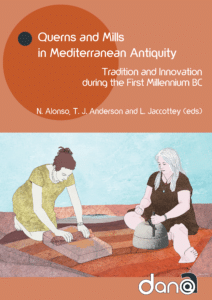UN@ est une plateforme d'édition de livres numériques pour les presses universitaires de Nouvelle-Aquitaine
Collection : DANA_12
After thousands of years of exclusively grinding with a to and fro motion, several new types of mills appeared and evolved in the Mediterranean during the last millennium BC.
The hopper rubber is a grinding tool associated with the spread of the ancient Greek world throughout the Mediterranean. Its presence is certified at certain Greek or Greek-influenced sites in the southeast of France during the second half of first millennium BC (Py 1992; Chausserie-Laprée 1998; Frankel 2003; Jaccottey et al. 2013).
The 1st millennium BC in the western Mediterranean was a period marked by significant social and economic changes. Deriving from a surge of connections within the Mediterranean, these changes are evidenced by new settlement patterns, technological innovations and the emergence of complex social and political organisations.
The oldest rotary mills in the Mediterranean and Europe which have been widely published (e.g., Alonso 1999, 2015; Alonso & Frankel 2017) are recorded in the middle of the 1st millennium BC in the framework of the dawn of the Iberian Civilisation (Early Iberian period) throughout the northeast of the Iberian Peninsula to the south of France.
The Lez River Valley runs roughly from north to south through Languedoc’s coastal plain to the east of Montpellier. The Late Bronze Age oppidum of Sextantio at the foot of the first limestone massiFs a few kilometres inland is this valley’s first major Protohistoric occupation.
The grinding tools from Protohistory to Late Antiquity along France’s Mediterranean coastline have not, to date, been the object of a systematic survey. This renders the current study of nearly 200 grinding stones unearthed during different excavations of the Greek colony of Olbia de Provence even more relevant.
Hundreds of querns and mills have been recovered and recorded from all stratigraphic phases at the site Tel Zayit (1999-2011) during the nine excavation seasons.
par David Eitam
Ground stones throughout prehistory served to produce, process and store sources of subsistence as well as to manufacture other stone tools (Fig. 1).
par Sophie Duchène
Numerous studies of the last decades have emphasised the potential of volcanic grinding stones in unravelling past Mediterranean exchange networks and trade routes.
par Dominique Garcia
The city and its relationship with the countryside is undoubtedly the process that most often characterises Mediterranean Antiquity. This relates to Phoenician and Punic ports (both eastern and western), Etruscan centres, Greek poleis and Roman civitates as well as Iberian and Celtic fortresses and oppida.
The session Querns and Mills in Mediterranean Antiquity: Tradition and Innovation during the First Millennium BC was organised in the framework of the annual conference held in Barcelona (2018) by the European Association of Archaeologists (EAA).


